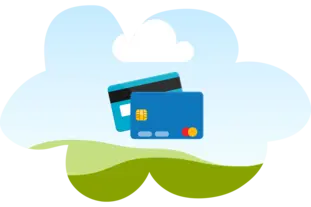TABLE OF CONTENTS
- What Is SumUp?
- How Does SumUp Work?
- SumUp Features & Services
- SumUp App Review
- Methods of Payment Acceptance
- SumUp Card Readers and Hardware
- SumUp vs POS
- SumUp Fees & Costs
- SumUp Pros and Cons
- SumUp Ease of Use
- Lawsuits and Complaints
- SumUp Alternatives
- Is SumUp Right for Your Business?
- Frequently Asked Questions (FAQs)

If you’re a new business owner looking to process credit card transactions, you may have considered SumUp. It directly competes with other popular small business payment solutions like Square. While SumUp has a relatively low rating on the app stores (both Google Play and iOS), that may not be entirely justified. If you’re on the fence about whether or not SumUp is right for your business, we’re here to help. In this article, we are going to take an in-depth look at SumUp; including what SumUp is, the SumUp Desktop app, what the SumUp Card reader is, whether the SumUp card reader reviews are justified, and more.
What Is SumUp?
SumUp is a UK-based payment services provider founded in 2012. It offers both its SumUp app and SumUp card readers that allow businesses to accept credit and debit card payments. As we touched on, SumUp is a direct competitor with Square, though since it is UK-based, many of its more robust features are not yet available to merchants in the US. (Note: this is subject to change over time). Similar to Square, SumUp is best suited to low-volume, small-ticket, inconsistent volume, or mobile in-person sales-based businesses.
How Does SumUp Work?
SumUp’s primary product and service in the US focuses on mobile processing. Put simply, mobile processing encompasses any payments processed using your smartphone. Examples of the most frequent use cases for mobile processing are retail businesses that do pop-up stores, farmer’s market booths, or trade shows. In other words, any inconsistent retail environment is a perfect candidate for mobile processing.
The SumUp card reader connects to a smartphone or tablet via Bluetooth. It features a simple design that makes it relatively easy to use. The card reader connects to the SumUp mobile app, which offers insights and analytics (i.e., it allows businesses to track their sales and customers). SumUp is currently available in the United States, a few South American countries (like Brazil and Chile), and most of Europe (in countries like the United Kingdom, Ireland, Germany, Austria, Belgium, Netherlands, and Luxembourg).
To start using SumUp, businesses simply need to create an account and download the SumUp app. Once the account is created, merchants can purchase a card reader, add their bank account information, and start accepting credit and debit card payments through their smartphones.
SumUp Features & Services
As we’ve mentioned a few times already, SumUp is based in the UK. Because of this, there are some features that are not yet available to businesses in the US. Although SumUp does not have as many features as some of its competitors, several of those missing features aren’t actually necessary in most use cases. In this section, we will look at some of SumUp’s features, the SumUp app, and other services provided by SumUp.

Virtual Terminal
A virtual terminal allows merchants to accept card-not-present payments (examples include sales taken over the phone or mail-in orders where you, the merchant, add the payment card information on your end). The virtual terminal feature also offers the ability to send a payment link to accept payments from text, email, or even social media when a customer is not present. SumUp does offer a free virtual terminal, but it is not a standard feature.
To get this feature, you will have to apply for it separately – it does not come with a SumUp account. SumUp is relatively picky about who gets accepted to use a virtual terminal, so if your business is brand new with SumUp, it might not be possible for a while.

Invoicing
SumUp has made invoicing easy. Both on the mobile app or the SumUp desktop app, you can track, create, and send all invoices in one place. SumUp has done its best to make this as simple as possible and even has a preview setting where you can preview invoicing before sending. It is completely free to use. You only pay a fee if the customer pays using a credit card. This is a great feature for new business owners.

Dashboard & Analytics
The SumUp dashboard (available on both their desktop and mobile app) is a very useful tool to get a quick overview of your business payments.
The dashboard allows you to create/send invoices, process payments, update business information, and even contact customer support if you need help. It also gives you an overview of your sales, basic business and transaction reports, and transaction history (you can filter by the employee, if applicable, using the dashboard as well).
SumUp App Review
The SumUp app gets mixed reviews. For now, the major things to note are that there are far more reviews for the SumUp app written by European customers than US-based customers and far more Android reviewers than Apple. This uneven distribution means that there is skewed data that may be less relevant to the average American user. We’ll go more in-depth about the implications a bit later in the article (or scroll to the “SumUp Merchant Reviews” section).
Methods of Payment Acceptance
As we’ve explored, SumUp allows businesses to accept credit and debit card payments (specifically, Visa, American Express, Diners, Discover, and MasterCard). Methods for acceptance include:
- Mobile payments
- SumUp QR codes
- Contactless payments through the SumUp NFC card reader (such as Apple Pay and Google Pay, or Tap-and-go contactless card payments)
- SumUp gift cards
- Payment links
- Virtual terminal
SumUp Card Readers and Hardware
As far as hardware goes, SumUp has three main offerings in the US:
1. SumUp Plus ($54) is a standalone device that can accept payments. The SumUp Plus device:
- Uses SumUp desktop app
- Accepts NFC contactless card payments, Apple Pay, Google Pay, EMV chips, and magstripe
- Bluetooth connection
- LED screen
- Tip function
- Battery life of 50+ transactions
- Free US shipping
2. SumUp Solo ($99) is a standalone device that can accept payments, send digital receipts, and access reports:
- Standalone unit
- Accepts NFC contactless card payments, Apple Pay, Google Pay, EMV chips, and magstripe
- Tip and refund functionality
- Employ profile/login
- Wi-fi and cellular connection
- Charging station
- Battery life of up to 50 transactions
- Free US shipping
3. Sum Solo Printer ($169) is a simple device that can accept payments attached to your dashboard and print receipts:
- Has Bluetooth connection
- Accepts NFC contactless card payments, Apple Pay, Google Pay, EMV chips, and magstripe
- Requires digital signature
- Optional charging station
- Battery life of up to 300 transactions
- Free US shipping
- Comes with a battery pack/printer and three paper rolls
SumUp vs POS
If you’re looking to accept credit and debit card payments for your business, you might be wondering whether you need a SumUp card reader or a full-blown SumUp POS system. Both can process card payments, but they differ in several key ways:
- Cost: A full-blown POS system is much more expensive than a SumUp card reader. However, for that extra cost, a POS system also offers additional features, such as tracking inventory and managing employees.
- Target market: POS systems are typically used by larger businesses, while card readers are targeted toward smaller businesses.
- Business Type: Most POS systems are designed with a business’s specifics in mind. For example, a restaurant POS system would offer tipping, bar tab functionality, and back-of-house order printers.
- Portability: A POS system usually cannot move quickly, while card readers are built for portability.
SumUp Fees & Costs
Let’s take a deeper look at what SumUp’s fees are and how much your business can plan to spend based on the package, transaction, and card reader you choose.
One-time hardware costs:
- SumUp Plus card reader: $54
- Plus Bundle (SumUp Plus card reader with charging dock): $65
- SumUp Solo card reader: $99
- SumUp Solo Printer: $169
Ongoing transaction costs:
- In-person transactions: 2.75%
- Remote transactions (payment link, virtual terminal, or gift card transactions): 3.25% + $0.15
- Invoice transactions: 2.90% + $0.15
- Chargebacks: $10
How much does SumUp charge?
As we look at the section above, you can see that there are no monthly or setup fees. Instead, SumUp charges a flat rate depending on how you processed the transaction. For most retail use cases, you will pay the 2.75% in-person transaction rate. This means that for every $10 you charge, you’ll pay $0.28. With Square, in contrast, that same $10 transaction would cost $0.36 (Square’s in-person rate is 2.60% + $0.10), which can make a significant difference in the effective rate for low average-ticket merchants.
Note: if you believe your business has a unique case for a personal quote on merchant services, SumUp will also accommodate that request.
You can choose the SumUp card reader that best suits your business needs. Regardless of the card reader you choose, the transaction fees remain the same.
SumUp Pros and Cons
Like all companies, SumUp has pros and cons, so let’s take a look at each.
Pros
- User Friendliness: Setting up a SumUp account is easy and takes just a few minutes. The SumUp desktop app is also clean and easy to navigate.
- Portability: SumUp card readers are small and portable, making them ideal for small businesses that operate at farmer’s markets, outdoors, or pop-ups.
- Cost: One of SumUp’s main benefits is that there is no monthly fee. It is a pay-as-you-go plan. As a business, you will pay a transaction fee and an upfront cost for your terminal.
- Unlimited employee logins: You can add as many employee logins as you need on their mobile app.
Cons
- Lack of features: The SumUp app is clean and straight to the point. It’s not for businesses that want lots of features.
- Not good for high-risk merchants: SumUp does not protect high-risk merchants or (any merchants, for that matter) against chargebacks. SumUp will charge $10 per chargeback (in addition to the cost of the customer refund). So, using SumUp in a higher-risk industry may not be a good choice.
- Limited offline payments: SumUp reviews have stated several connection issues are making it hard to process transactions at times.
SumUp Ease of Use
All things considered, SumUp is very easy to use. You just need to download the app and create an account that requires two-step verification. As we mentioned earlier, SumUp card readers are small and portable, making them ideal for many business types. The SumUp app is also very clean and user-friendly. Even those who are not tech-savvy seem to have very few problems navigating the terminal and mobile app. If your business is looking for a user-friendly and easy-to-use payment option, SumUp should be on your list!
Better Business Bureau Rating
According to the Better Business Bureau (BBB), SumUp has a rating of “C-” due to a rise in recent complaints.[1]Better Business Bureau. “SumUp Inc. BBB”. Accessed April 18, 2024. As of writing, SumUp is not a BBB-accredited business.
SumUp Merchant Reviews
Let’s now take a look at how other merchants and consumer protection sites have reviewed SumUp:
- Trustpilot: 3.1 stars out of 5.
The most frequent complaint is that SumUp terminated an account or refused to let a business process after it signed up.
SumUp does not support high-risk businesses. You may be surprised to discover what industries and businesses are considered high-risk. It is important to verify your business is eligible for SumUp before investing in equipment. You can review that list here.
Lawsuits and Complaints

Consistent complaints have been received on consumer channels. These include complaints about customer service, withholding funds, funds arriving later than expected, and device malfunctions.
SumUp is quick to respond to equipment malfunctions and resolve problems. As for the other complaints, most of the issues stem from the common problems merchants report with payment service providers like Square and PayPal; more on that next. They tend to boil down to merchants exhibiting inconsistent processing behavior (such as processing a bigger-than-average transaction) or using the account in a way that isn’t allowed (i.e., running a high-risk business through the platform).
So, to sum it up (pun intended), SumUp is a safe and reputable choice, but you need to do your due diligence to ensure it’s the right choice for your business.
SumUp Alternatives
When it comes to payment processing, there are many alternatives to SumUp.
SumUp is a payment service provider (PSP). PSPs are retail payment processors (processors that offer you access to their merchant accounts). The PSP companies that are most similar to SumUp are Square and PayPal. Let’s take a quick look at each of these transaction charges and monthly fees to give you a bit of a cost comparison.
PayPal
- Monthly Fee: $0
- Card Transaction: 2.7%
- Keyed Transaction: 5% + fixed fee
- ECommerce Transaction: 3.4% + $0.30
Square
- Monthly Fee: $0
- Card Transaction: 2.6% + $0.10
- Keyed Transaction: 3.5% + $0.15
- Ecommerce Transaction: 2.9% + $0.30
Just like any other payment services provider, your account eligibility and stability are not guaranteed. If you operate a high-risk business, run large transactions, or need consistent funding times, your business may be more stable with a full merchant account.
Is SumUp Right for Your Business?
SumUp is a user-friendly card reader with low transaction fees. For many new or small businesses, it’s all you need to get started with a new venture. However, SumUp does not offer many features and doesn’t support several different business types.
Choosing the right payment solution is crucial if you’re a new business owner. The right partner will be able to save you money on transaction fees, provide high-quality customer service, and offer helpful features like fraud protection and mobile payment processing. On the other hand, the wrong solution can cost you a lot of money in fees, give you terrible customer service, and make it difficult for your customers to pay you. In today’s competitive business world, choosing a credit card processing solution can be the difference between success and failure, so take your time and do your research!
Frequently Asked Questions (FAQs)
Is SumUp safe?
From a customer protection standpoint and business practices standpoint, yes. SumUp is a safe and reputable company that meets PCI DSS standards.[2]PCI. “PCI DSS”. Accessed April 18, 2024.
Does SumUp have a monthly fee?
No, there is no monthly fee for SumUp. SumUp fees are included in each purchase/transaction, so you will not pay a monthly cost but a flat rate for each transaction.
How long does it take to get money from SumUp?
SumUp processes transactions daily. Their website states that funding is as quick as one to two business days.
Which is better, Square or SumUp?
Square and SumUp are both good options for new business owners. Square may be the more technical option as it has more features; however, SumUp’s low cost and user-friendliness make it a strong competitor.
Do I need a bank account with SumUp?
Yes, you will need a bank account to use SumUp.
Does SumUp report to IRS?
Yes, SumUp is required to report your sales to the IRS by law, but they do not withhold taxes on your behalf. The company is also registered with the Financial Crimes Enforcement Network (FinCEN) and is required to comply with applicable anti-money laundering laws and regulations.
What bank does SumUp use?
SumUp has partnered with Starling Bank to make daily payouts possible for SumUp. However, depending on your business’s needs, you can choose daily, weekly, or monthly payouts.
Where is SumUp based?
SumUp was founded in 2012 and is headquartered in London, England. It is a global company that offers its services in countries such as the United States, the United Kingdom, Ireland, Germany, Austria, Belgium, the Netherlands, and Luxembourg.





